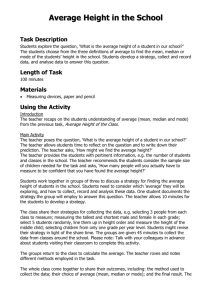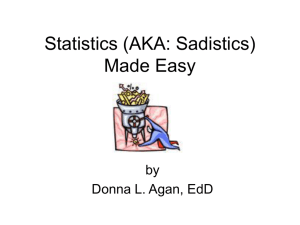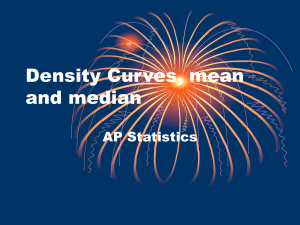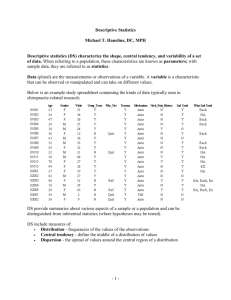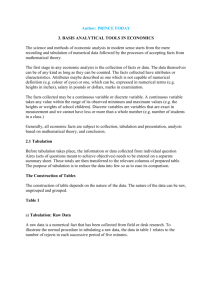Chapter 1: Descriptive Statistics
advertisement
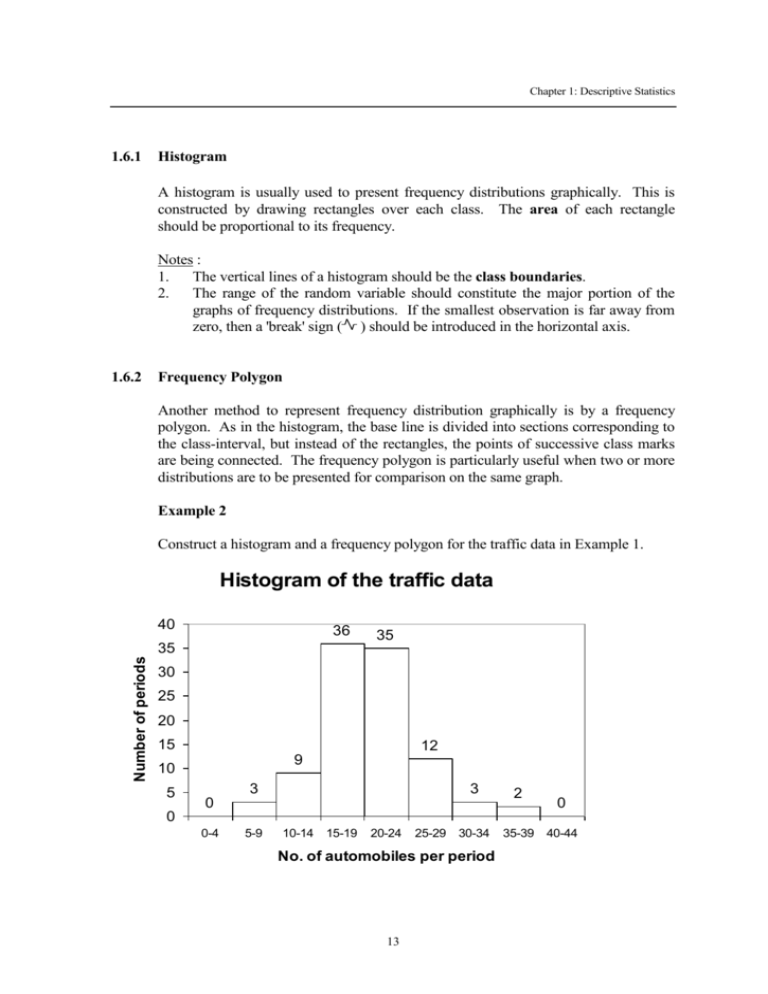
Chapter 1: Descriptive Statistics 1.6.1 Histogram A histogram is usually used to present frequency distributions graphically. This is constructed by drawing rectangles over each class. The area of each rectangle should be proportional to its frequency. Notes : 1. The vertical lines of a histogram should be the class boundaries. 2. The range of the random variable should constitute the major portion of the graphs of frequency distributions. If the smallest observation is far away from zero, then a 'break' sign ( ) should be introduced in the horizontal axis. 1.6.2 Frequency Polygon Another method to represent frequency distribution graphically is by a frequency polygon. As in the histogram, the base line is divided into sections corresponding to the class-interval, but instead of the rectangles, the points of successive class marks are being connected. The frequency polygon is particularly useful when two or more distributions are to be presented for comparison on the same graph. Example 2 Construct a histogram and a frequency polygon for the traffic data in Example 1. Histogram of the traffic data 40 36 35 Number of periods 35 30 25 20 15 12 9 10 5 3 3 0 2 0 0 0-4 5-9 10-14 15-19 20-24 25-29 30-34 No. of automobiles per period 13 35-39 40-44 Chapter 1: Descriptive Statistics Frequency polygon for the traffic data Number of periods 40 35 30 25 20 15 10 5 0 0 10 20 30 40 No. of automobiles per period 1.6.3 Frequency Curve A frequency curve can be obtained by smoothing the frequency polygon. 1.6.4 Cumulative Frequency Distribution and Cumulative Polygon Sometimes it is preferable to present data in a cumulative frequency distribution, which shows directly how many of the items are less than, or greater then, various values. Less than 4.5 9.5 14.5 19.5 24.5 29.5 34.5 39.5 Cumulative frequency 0 3 12 48 83 95 98 100 14 Chapter 1: Descriptive Statistics Example 3 Construct a “Less-than” ogive of the distribution of traffic data. "Less-than" ogive Cumulative number of periods 120 100 80 60 40 20 0 0 5 10 15 20 25 30 35 40 No. of automobiles per period (Less than) 1.6.5 Cumulative Frequency Curve A cumulative frequency curve can similarly be drawn. 1.6.6 Relative Frequency Relative frequency of a class is defined as: Frequency of the Class Total Frequency If the frequencies are changed to relative frequencies, then a relative frequency histogram, a relative frequency polygon and a relative frequency curve can similarly be constructed. Relative frequency curve can be considered as probability curve if the total area under the curve be set to 1. Hence the area under the relative frequency curve between a and b is the probability between interval a and b. 15 Chapter 1: Descriptive Statistics Example 4 Construct a relative frequency distribution and a percentage distribution from the traffic data in Example 1. 1.7 Central Tendency When we work with numerical data, it seems apparent that in most set of data there is a tendency for the observed values to group themselves about some interior values; some central values seem to be the characteristics of the data. This phenomenon is referred to as central tendency. For a given set of data, the measure of location we use depends on what we mean by middle; different definitions give rise to different measures. We shall consider some more commonly used measures, namely arithmetic mean, median and mode. The formulas in finding these values depends on whether they are ungrouped data or grouped data. 1.7.1 Arithmetic Mean The arithmetic mean, , or simply called mean, is obtained by adding together all of the measurements and dividing by the total number of measurements taken. Mathematically it is given as f x f i i i 16 Chapter 1: Descriptive Statistics Where - for grouped data: fi - is the frequency in the ith class, xi - is the class mark in the ith class; for ungrouped data: fi - is the frequency in the ith datum, xi - is the value in the ith datum. Arithmetic mean can be used to calculate any numerical data and it is always unique. It is obvious that extreme values affect the mean. Also, arithmetic mean ignores the degree of importance in different categories of data. Example 5 Given the following set of ungrouped data: 20, 18, 15, 15, 14, 12, 11, 9, 7, 6, 4, 1 Find the mean of the ungrouped data. mean 20 18 2 15 14 12 11 9 7 6 4 1 12 132 12 11 1.7.2 Weighted Arithmetic Mean In order to consider the importance of some data, different weighting factors, wi , can be assigned to individual datum. Hence the weighted arithmetic mean, , is given as: 17 Chapter 1: Descriptive Statistics f w x f w i i i Where 1.7.3 i i wi is the weight for the ith datum. fi and xi are defined same as those in the arithmetic mean for ungrouped and grouped data. Median Median is defined as the middle item of all given observations arranged in order. For ungrouped data, the median is obvious. In case of the number of measurements is even, the median is obtained by taking the average of the middle. Example 6 The median of the ungrouped data:: 20, 18, 15, 15, 14, 12, 11, 9, 7, 6, 4, 1 is 12 11 2 = 11.5 For grouped data, the median can be found by first identify the class containing the median, then apply the following formula: n C 2 median l1 (l2 l1 ) fm where: l1 n C fm l2 is the lower class boundary of the median class; is the total frequency; is the cumulative frequency just before the median class; is the frequency of the median; is the upper class boundary containing the median. It is obvious that the median is affected by the total number of data but is independent of extreme values. However if the data is ungrouped and numerous, finding the median is tedious. Note that median may be applied in qualitative data if they can be ranked. 18


